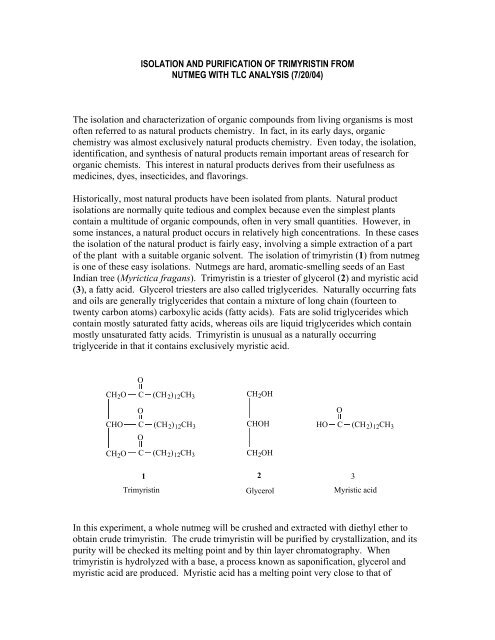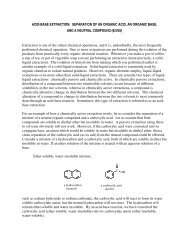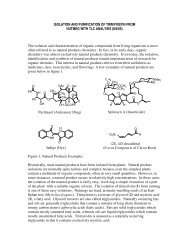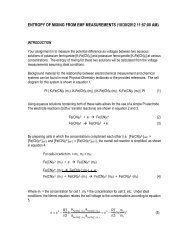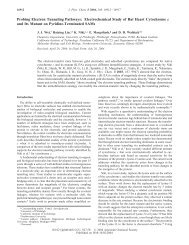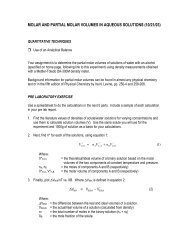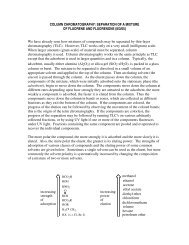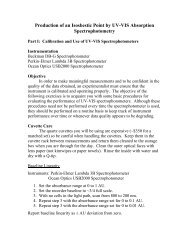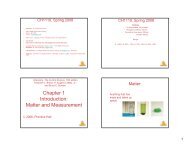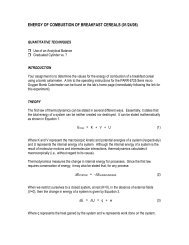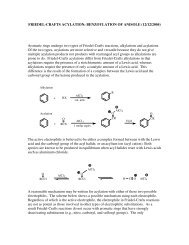Trimyristin Exp - Chemistry
Trimyristin Exp - Chemistry
Trimyristin Exp - Chemistry
Create successful ePaper yourself
Turn your PDF publications into a flip-book with our unique Google optimized e-Paper software.
ISOLATION AND PURIFICATION OF TRIMYRISTIN FROMNUTMEG WITH TLC ANALYSIS (7/20/04)The isolation and characterization of organic compounds from living organisms is mostoften referred to as natural products chemistry. In fact, in its early days, organicchemistry was almost exclusively natural products chemistry. Even today, the isolation,identification, and synthesis of natural products remain important areas of research fororganic chemists. This interest in natural products derives from their usefulness asmedicines, dyes, insecticides, and flavorings.Historically, most natural products have been isolated from plants. Natural productisolations are normally quite tedious and complex because even the simplest plantscontain a multitude of organic compounds, often in very small quantities. However, insome instances, a natural product occurs in relatively high concentrations. In these casesthe isolation of the natural product is fairly easy, involving a simple extraction of a partof the plant with a suitable organic solvent. The isolation of trimyristin (1) from nutmegis one of these easy isolations. Nutmegs are hard, aromatic-smelling seeds of an EastIndian tree (Myrictica fragans). <strong>Trimyristin</strong> is a triester of glycerol (2) and myristic acid(3), a fatty acid. Glycerol triesters are also called triglycerides. Naturally occurring fatsand oils are generally triglycerides that contain a mixture of long chain (fourteen totwenty carbon atoms) carboxylic acids (fatty acids). Fats are solid triglycerides whichcontain mostly saturated fatty acids, whereas oils are liquid triglycerides which containmostly unsaturated fatty acids. <strong>Trimyristin</strong> is unusual as a naturally occurringtriglyceride in that it contains exclusively myristic acid.OCH 2 OC(CH 2 ) 12 CH 3CH 2 OHOOCHOC(CH 2 ) 12 CH 3CHOHHOC (CH 2 ) 12 CH 3OCH 2 OC(CH 2 ) 12 CH 3CH 2 OH12 3<strong>Trimyristin</strong> Glycerol Myristic acidIn this experiment, a whole nutmeg will be crushed and extracted with diethyl ether toobtain crude trimyristin. The crude trimyristin will be purified by crystallization, and itspurity will be checked its melting point and by thin layer chromatography. Whentrimyristin is hydrolyzed with a base, a process known as saponification, glycerol andmyristic acid are produced. Myristic acid has a melting point very close to that of
trimyristin so that a melting point alone is not sufficient for distinguishing trimyristinfrom myristic acid. However trimyristin and myristic acid may be readily distinguishedby thin layer chromatography.<strong>Exp</strong>erimental ProcedureFirst LabCrush and grind a whole nutmeg with a mortar and pestle for approximately 5 min. (noneed to pulverize). Weigh the ground nutmeg and transfer it to a 50 mL round-bottomedflask. Add 15 mL of diethyl ether, attach a water-cooled condenser to the flask, and heatthe mixture under a gentle reflux for approximately 15 min. on a steam plate. Allow themixture to cool to room temperature. Without disturbing the settled solids, decant andgravity-filter the ether solution into a 125 mL Erlenmeyer flask. Add another 10 mL ofdiethyl ether to the solid residue, swirl for a few minutes, and transfer the contents to thefilter. Prepare a TLC plate and apply a small amount of the filtrate (crude product).(Wait until the following week to develop in a chamber.) Finally, add a boiling stick tothe filtrate and evaporate the ether on a steam plate in the fume hood.Second LabAdd sufficient reagent grade acetone to dissolve the remaining crude solid product(approximately 3-5 mL of acetone, the amount will vary depending upon the weight ofnutmeg extracted). Allow to cool to room temperature. Collect the crystalline trimyristinby vacuum filtration and allow it to air-dry. Weigh the product and calculate the percentof trimyristin in the nutmeg.Place a small amount (the tip of a spatula) of the purified trimyristin in a test tube, thenadd a drop or two of chloroform. Do likewise with the crude product. Next, obtain asmall amount of prepared myristic acid (saponified trimyristin) and dissolve inchloroform (same amounts/procedure as used for trimyristin & crude product). Spot theTLC plate with each of the chloroform solutions and develop the plate using chloroformas the solvent. Place the plate under UV light and observe. Next, develop the plate in aniodine chamber. Note that myristic acid adsorbs less iodine than the surrounding silicagel and appears as a white spot on a yellow-brown background.Place some dry trimyristin, just enough to see, in a melting point capillary. Do likewisewith a small amount of prepared myristic acid and determine the melting point of the twocompounds. The melting point should be near 56 o C. Remember that melting pointdeterminations are most accurate when the temperature rise near the melting point(within 10°C) is approximately 1-2 o C/min. Prepare the TLC plate in a manner consistant with those prepared in the lab’sintroductory experiment, “TLC of Analgesics”.
Do not discard TLC plates. Attach to the postlab exercise form. Perform purification, TLC and melting point analysis during 2 nd week of thisexperiment. Always use a flask (not a beaker) to contain volatile reagents. A flask must always beused for crystallization/recrystallization procedures!WASTE DISPOSAL NOTES: Nutmeg, <strong>Trimyristin</strong>, and Myristic Acid should all be disposed of inthe Non-hazardous Solid Waste Container (located in the Waste Hood)REFLUX APPARATUSNOTE: Use a hose clamp to anchor hoses to the condenser inlet and outlets!
Name:__________________________________ Section:_______ Date:_______POSTLAB EXERCISE FOR:Extraction of <strong>Trimyristin</strong> from Nutmegwith TLC Analysis (7/20/2004)>> Due no later than the 2 nd Friday following the scheduled experiment; no exceptions willbe made! Please answer questions on this form. (30pts TOTAL)
B. SUMMARY QUESTIONS (15pts)1) (4pts) Is melting point determination or thin-layer chromatography analysis abetter method to determine the purity of trimyristin? <strong>Exp</strong>lain.2) (4pts) Was the melting point or thin-layer chromatography a better method fordistinguishing between the compounds trimyristin and myristic acid? <strong>Exp</strong>lain.3) (4pts) Why was the whole nutmeg crushed and ground before it was extractedwith diethyl ether?4) (3pts) Would water be a suitable solvent for extracting trimyristin from nutmeg?


